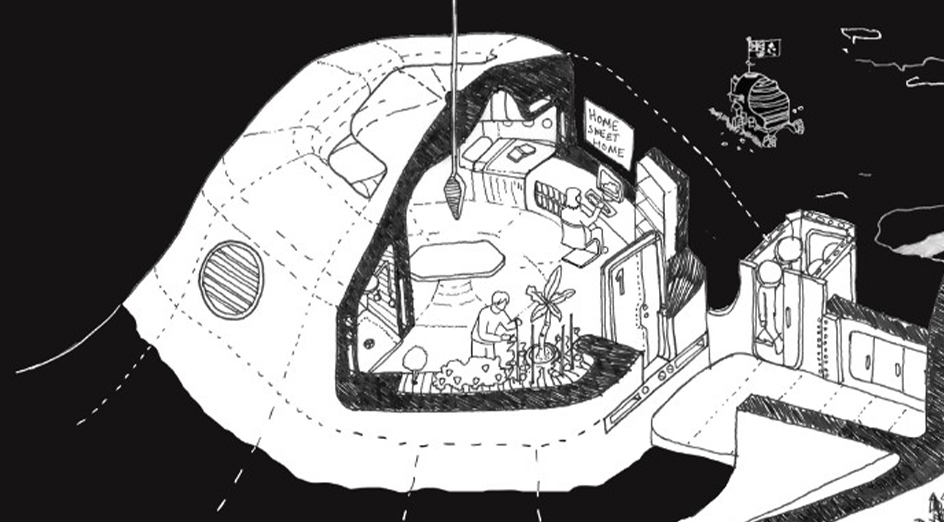Imagine celebrating your birthday or Christmas on the Moon, roughly 384,400 kms from Earth, surrounded by spherical habitats that feel as much like home as possible.
For a team of four from The University of Western Australia, that's not science fiction – it's their architecturally inspired vision for humanity's future in space.
With their concept 'Happy Homesick', the creative cohort clinched top prize in the Australian Space Architecture Challenge by rethinking what it means to truly live, thrive, and belong on the Moon.

Image: A place to call home...the Happy Homesick design.
Lecturer Dr Rob Cameron, from the Australian Urban Design Research Centre and UWA's School of Design, and architecture students JD Otto, Claire Basso and Eric Luan, explored what long-term life on the Moon might feel like if we were to embrace the environment, rather than merely endure it.
Organised by the Andy Thomas Centre for Space Resources (ATCSR) at the University of Adelaide, the competition challenged participants from across Australia to envision human habitats that go beyond basic survival, fostering psychological and emotional well-being in deep space.
Head of the Lunar Architecture Research Group at ATCSR, Dr Amit Srivastava, said the contest aimed to stimulate cross-disciplinary innovation that aligned with Australia's ambitions in the global space economy.
"We challenged students to play at the boundaries of reality and imagination and contribute a vision of the future of human habitation on the Moon in 2069," Dr Srivastava said.

Image: The winning team (left to right) JD Otto, Dr Rob Cameron, Claire Basso and Eric Luan.
For the UWA team, those boundaries involved considering the whole human experience of a life in space – from farming and child-rearing to emotional health, in a stark and inhospitable lunar landscape.
Their concept looked at how future generations could build genuine connections to off-Earth environments.
"Our project explored what a truly lunar or Martian architecture might look like, and whether a human born in space could feel at home in the most extreme kind of environments that you could possibly imagine," Dr Cameron explained.
"We started to imagine habitats that don't just mimic Earth but created a unique 'sense of place' on the Moon."
Over five weeks of workshopping ideas, front of mind for the team was the undeniable fact that long-term space habitation poses profound psychological and physical challenges.
They decided to address these issues by designing dome-like structures that would serve as a whole lot more than just shelter.

Image: Designing for the long-term.
"Space technology and business has advanced rapidly in the last decade and with that there's been this idea that colonisation of the Moon and Mars is just around the corner," Dr Cameron said.
"As we read up more on the topic, we discovered that proponents of this hype have largely ignored critical questions around the psychology and health implications of living in deep space.
"There are lots of things about space that most people aren't aware of – the loss of bone density caused by low gravity, the impacts of radiation on the body, or the abrasive and toxic materials that permeate the lunar and Martian soil.
"When it comes to living in space beyond short-term missions there is a lot we don't know – for example, how do we make space kids, space farms, or manage the amount of labour required to sustain ourselves without losing our sanity?
"We thought if we wanted to feasibly and ethically explore space in the future, a well-designed moon outpost could allow us to answer these questions!"

Image: A well-designed 'moon outpost where people could truly feel at home.
For the students, as well as the opportunity to stretch their design skills, there were other upsides to taking part in the competition.
"Surprisingly, even though we were designing for one of the most extreme environments imaginable, we didn't have to factor in anything else by way of other people, other buildings, other infrastructure – it was a bit of clean slate, which was something we hadn't thought about," Eric said.
"I've just started my Masters so it's been a really great professional, collaborative experience with the team that I've not really experienced through my study - it's been super valuable for me."
Eric Luan, UWA Masters student
"I've just started my Masters so it's been a really great professional, collaborative experience with the team that I've not really experienced through my study - it's been super valuable for me."
For Claire, the chance to 'work' in space was also a game-changer.
"I think it's been really good for us, just given everything that's happening in the world at the moment, just to have a bit of a breather and a distraction and a bit of escapism," Claire said.
"We've already moved onto our next competition, which is to design accommodation for war-torn Ukraine, so it sparked something in us all I think."
The project was featured at the International Astronautical Congress in Milan, showcasing Australia's growing expertise in space architecture and interdisciplinary design.
The Australian Space Agency and the South Australian Space Industry Centre supported the competition, highlighting Australia's commitment to advancing its role in the space industry.






